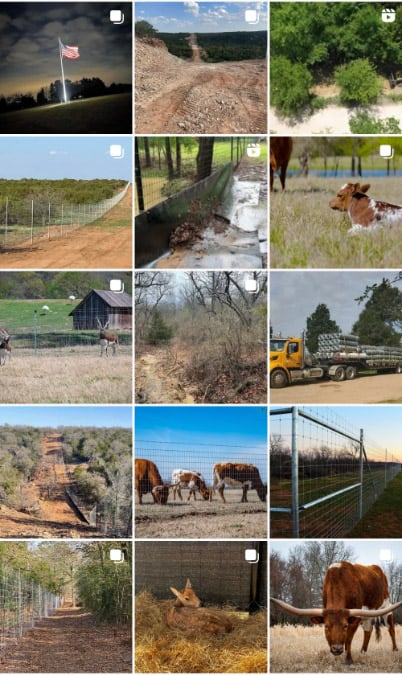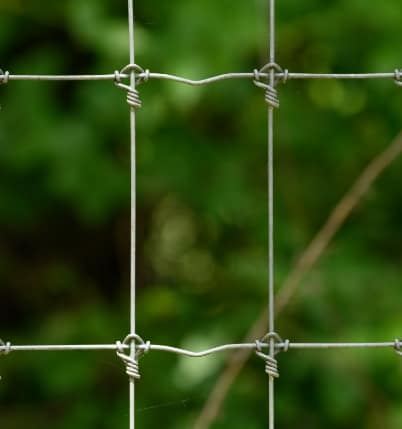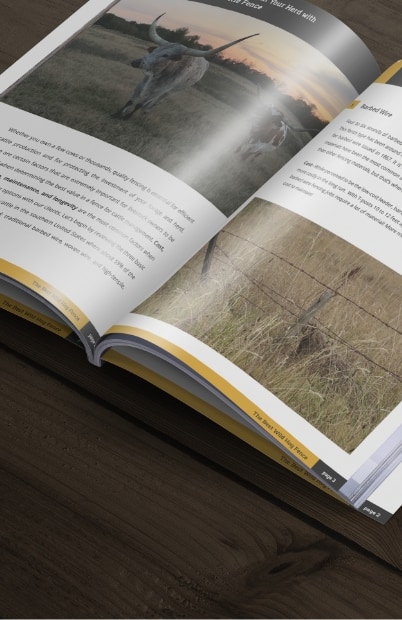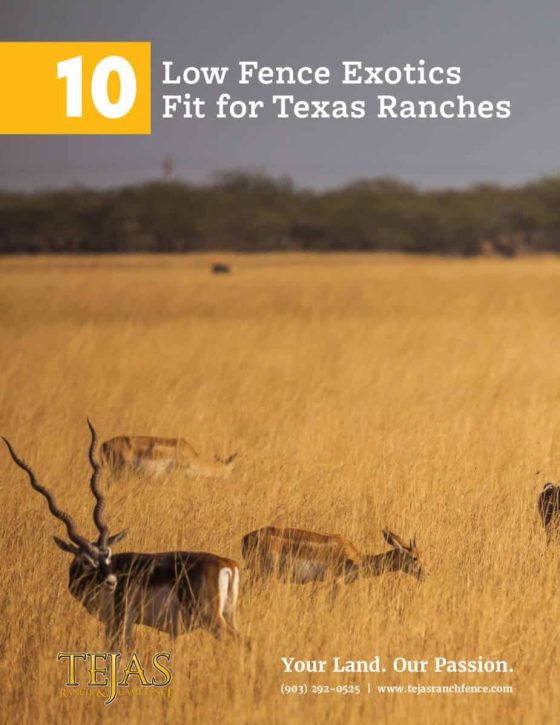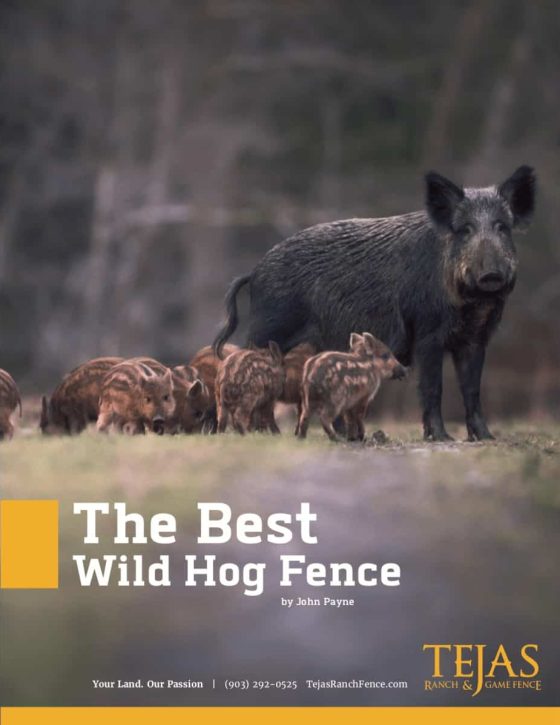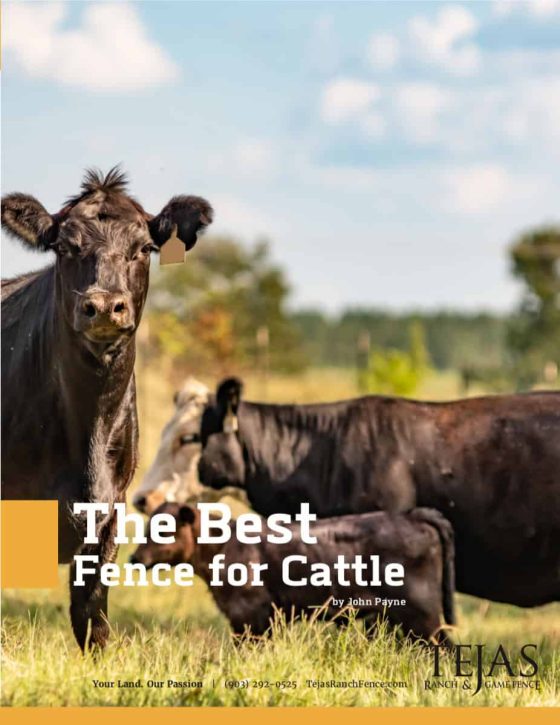Exotic Game Wildlife that Requires High-Fence
We often get asked, “What exotic game animals require a high fence?”
In this article, we will provide a list of exotic game animals that require a high fence. But first, let’s understand the basics of high-game fences.
Start with the Right High Fence Material
When considering a high fence, landowners should first determine the correct fencing style and materials.
High tensile woven wire steel mesh with a “fixed knot” fencing is the material of choice for exotics. This modern form of the old field fence consists of interconnected vertical and horizontal wires forming squares or rectangles of overlapping and knotted wires. It differs from field fences primarily in its strength and available patterns.
Woven wire comes in several varieties, but the main difference is the spacing between the wires, both vertically and horizontally. Depending on the purpose, high-fence hunting ranches can select fencing with more or less space between the wires. Woven wire fencing is commonly used with cattle and horses to prevent fence injuries and entanglements and to keep feral hogs from destroying the precious grass in pastures. It is also sturdier and less susceptible to livestock damage, which makes it a longer-lasting choice for a surprisingly small premium in price. Commercial hunting or breeding operations typically use this kind of high-grade, high-tensile, woven-wire steel mesh, known in the trade as fixed knot fencing.
Woven-wire, fixed knot basics: coating, knots, and spacing
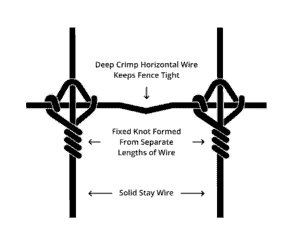 When selecting woven wire fences, there are three things to consider: galvanized coating, fixed knot design, and mesh spacing.
When selecting woven wire fences, there are three things to consider: galvanized coating, fixed knot design, and mesh spacing.
Class 3 galvanized high tensile wire and solid vertical stays require little to no maintenance, so high fence hunting ranches spend less time worrying about the integrity and durability of the fencing material. A fixed-knot design combined with high tensile wire makes this the most robust woven wire fence available and highly resistant to animal damage. The breaking strength of each horizontal wire is around 1,400 lbs.
The steel mesh spacing enables the fence to withstand stresses without losing shape or strength. The crimps in the horizontal wires are installed with significant tension or pressure to withstand force from livestock.
Woven wire is also much more visible than standard, five-strand barbed wire, making it a safer solution in many cases.
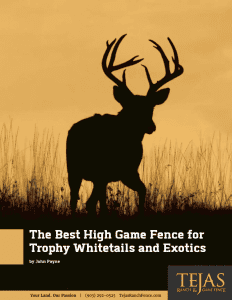 |
Interested in downloading and taking this article with you? Click to download the printable PDF version. |
Other considerations for High Fence Exotics
Before acquiring exotics for your ranch, you must consider how you’ll fence your property to ensure that your exotics have access to water, forage, protective vegetation, and supplemental feeding when the grass is insufficient or dormant. A professional ranch fence contractor can analyze your property to help identify your particular needs.
Water gaps
Water gaps along fence lines can be tricky. Tejas Ranch & Game Fence has created a proprietary solution, the FloatMaster™ Water Gap solution, that solves this age-old problem. During high-water events, the FloatMaster™ will allow debris to flow freely below a fence, and during dry seasons it lies flat on the ground to prevent animals from escaping and predators from entering.
Gates
Tejas installs gates to protect your exotics from dogs and predators. Typical gates constructed for cattle have gaps where the gates are attached to the fence posts and between round tubing. Tejas installs gates to protect your exotics from dogs and predators. Additionally, their exceptional gate latches are reliable and secure.
Tejas uses galvanized posts, T-posts, and wire for a uniform appearance and a longer-lasting fence as a standard offering. These materials enhance your investment and offer a minimal premium over ungalvanized fencing.
Feeding and drinking stations
Often overlooked, feeding stations and drinking systems can be critical. Appropriate nutrition is vital for any wildlife. Ensuring that your land can support additional grazers takes proper management. Automatic and gravity-fed feeders can be significant additions for exotics. Tejas sells a range of top-quality, reliable spin cast and protein feeders. Adding feeding stations along with new wildlife can ensure the success of your vision.
Texas summers can be brutal on livestock and exotic wildlife. Providing reliable water sources can reduce stress and ensure better health for your animals. Surface water stock tanks are the easiest hydration solution, but automatic waterers are a simple investment if you have water running to certain pastures.
Compatibility
Selecting the right high-fence exotics also requires research and careful consideration of habitat, climate, and species compatibility. Some species will hybridize, interbreed, or populate quickly if not kept in check. If you are introducing exotics with your native whitetails, consider that whitetail deer will likely land at the bottom of the pecking order for food if your property is at carrying capacity. Predator control is also necessary, as coyotes and feral hogs will kill fawns. (Learn about Tejas’ predator-proof fencing)
Local agricultural extension agents, wildlife biologists (with exotics expertise), and the Exotic Wildlife Association (EWA) can be excellent resources. They can help guide your choices alongside the Tejas Ranch & Game Fence team. The EWA has published a helpful list of seven tips for landowners considering adding exotics to their property.
High Fence Exotics List
Along with its expertise in designing and constructing fences for exotic enclosures, the Tejas team has curated a list of high-fence exotics suited for high-tensile fixed-knot fenced pastures.
-
-
-
Axis Deer
 It lives in grasslands and forests in India and Sri Lanka in herds of up to 100 or more. It stands 35–37 inches at the shoulder. Its spotted coat is reddish brown above and white below. The male chital has branching, usually three-tined antlers up to 100 cm long. Learn more about exotic Axis Deer.
It lives in grasslands and forests in India and Sri Lanka in herds of up to 100 or more. It stands 35–37 inches at the shoulder. Its spotted coat is reddish brown above and white below. The male chital has branching, usually three-tined antlers up to 100 cm long. Learn more about exotic Axis Deer. -
Nilgai Antelope
 The nilgai is indigenous to the Indian subcontinent, and Hindus accord it the same sacred status as cattle. Accordingly, the nilgai is the only one of the four Indian antelopes that are still abundant. The nilgai’s conformation is more horselike than cowlike: it has a long neck with a short upright mane, a narrow bony head, a barrel-like chest, and strong legs. Maximum contrast is achieved in prime males, which turn nearly black. They grow much bigger than cows, up to 5 feet tall and 660 pounds, compared with 471 pounds for cows; they also have a thicker neck and a tassel of black hair bordering the white bib. Learn more about exotic Nilgai Antelope.
The nilgai is indigenous to the Indian subcontinent, and Hindus accord it the same sacred status as cattle. Accordingly, the nilgai is the only one of the four Indian antelopes that are still abundant. The nilgai’s conformation is more horselike than cowlike: it has a long neck with a short upright mane, a narrow bony head, a barrel-like chest, and strong legs. Maximum contrast is achieved in prime males, which turn nearly black. They grow much bigger than cows, up to 5 feet tall and 660 pounds, compared with 471 pounds for cows; they also have a thicker neck and a tassel of black hair bordering the white bib. Learn more about exotic Nilgai Antelope. -
Aoudad Sheep

The aoudad stands about 40 inches at the shoulder. It has a fringe of long, soft hair hanging from its throat and forequarters and has semicircular horns that curve outward, back, and inward over the neck. Learn more about exotic Aoudad Sheep.
-
Fallow Deer

The common fallow deer is native to the eastern Mediterranean. It stands about 3 feet at the shoulder; bucks weigh up to 220 pounds, and females 100 pounds. It prefers open woods where it feeds mainly on herbs and foliage and sometimes on woody browse and grasses. Its coat is usually yellowish brown with white spots in summer and is more uniformly grayish brown in winter. The antlers are broad, flattened at the ends, and have several short tines; they are the only Old World deer with flat antlers. Learn more about exotic Fallow Deer.
-
Sika Deer
 A small, forest-dwelling deer that is native to China, Korea, and Japan, where it was long considered sacred. It is farmed in China for its antlers, which are used in traditional medicine. Mature males of the smallest forms, the southern sikas, stand 31–34 inches at the shoulder and weigh about 180 pounds. Males of the most prominent forms, the northern sikas, such as Dybowski’s sika, stand approximately 40 inches at the shoulder and weigh 240 pounds. Females weigh about 60 percent as much as males. There is considerable geographic variation in size, coat characteristics, and color. Their coats are reddish brown and spotted in summer, dark brown, and sometimes without spots in winter. All have relatively long tails and a white rump patch rimmed by long white hair that can be flared wide in alarm. All mature stags grow a neck ruff in the fall. The four-tined antlers of older stags may exceed 33 inches in length in the north and 28 inches in the south.
A small, forest-dwelling deer that is native to China, Korea, and Japan, where it was long considered sacred. It is farmed in China for its antlers, which are used in traditional medicine. Mature males of the smallest forms, the southern sikas, stand 31–34 inches at the shoulder and weigh about 180 pounds. Males of the most prominent forms, the northern sikas, such as Dybowski’s sika, stand approximately 40 inches at the shoulder and weigh 240 pounds. Females weigh about 60 percent as much as males. There is considerable geographic variation in size, coat characteristics, and color. Their coats are reddish brown and spotted in summer, dark brown, and sometimes without spots in winter. All have relatively long tails and a white rump patch rimmed by long white hair that can be flared wide in alarm. All mature stags grow a neck ruff in the fall. The four-tined antlers of older stags may exceed 33 inches in length in the north and 28 inches in the south. -
Mouflon Sheep
 Native to the Mediterranean islands, the mouflon sheep is muscular with a noble build. It is very athletic and sleek in its stance, about 28 inches at the shoulder, and brown with white underparts. The male has a light, saddle-shaped mark on its back and has large, downward-curving horns with the tips turned outward. The female is usually hornless. Like domestic sheep, mouflons mainly eat grass but occasionally browse from shrubs or trees.
Native to the Mediterranean islands, the mouflon sheep is muscular with a noble build. It is very athletic and sleek in its stance, about 28 inches at the shoulder, and brown with white underparts. The male has a light, saddle-shaped mark on its back and has large, downward-curving horns with the tips turned outward. The female is usually hornless. Like domestic sheep, mouflons mainly eat grass but occasionally browse from shrubs or trees. -
Scimitar Oryx
 The male and female scimitar oryx sport the famed long, ribbed, backward-curving horns. Primarily white with reddish brown necks and markings, the scimitar oryx has a long, dark, tufted tail. These desert antelope stand up to 4.6 feet tall at the shoulder with a head and body length between 4.9 and 7.5 feet. They weigh approximately 220 pounds (females) and 460 pounds (males). Scimitar oryx live about 27 years in captivity. They are herbivorous, feeding on annual grasses, herbs, juicy roots, buds, and, when water is scarce, on fruits and vegetables. Hundreds of thousands of oryx roamed the Sahara and Sahel regions of Northern Africa only a century ago. Because of human disturbance, overhunting, drought, and excessive livestock grazing, the scimitar oryx is now believed to be extinct in the wild. Surveys show that Niger and Chad may have appropriate habitats for reintroduction, and some reintroductions have begun in Tunisia.
The male and female scimitar oryx sport the famed long, ribbed, backward-curving horns. Primarily white with reddish brown necks and markings, the scimitar oryx has a long, dark, tufted tail. These desert antelope stand up to 4.6 feet tall at the shoulder with a head and body length between 4.9 and 7.5 feet. They weigh approximately 220 pounds (females) and 460 pounds (males). Scimitar oryx live about 27 years in captivity. They are herbivorous, feeding on annual grasses, herbs, juicy roots, buds, and, when water is scarce, on fruits and vegetables. Hundreds of thousands of oryx roamed the Sahara and Sahel regions of Northern Africa only a century ago. Because of human disturbance, overhunting, drought, and excessive livestock grazing, the scimitar oryx is now believed to be extinct in the wild. Surveys show that Niger and Chad may have appropriate habitats for reintroduction, and some reintroductions have begun in Tunisia.
-
-
Wrapping up
We’ve covered a lot of ground. The takeaway: start with the proper high fence. High tensile wire mesh fencing with fixed knots is the best choice to contain high-fence exotic animals safely. Adding high fence exotics is doable with this fence material, water gap solutions, and feeding stations.
For additional information on high-fence exotics, call the professionals at Tejas Ranch & Game Fence.
Would you like more articles about high-fence exotics sent directly to your inbox? Sign up for our newsletter.
 |
Interested in downloading and taking this article with you? Click to download the printable PDF version. |
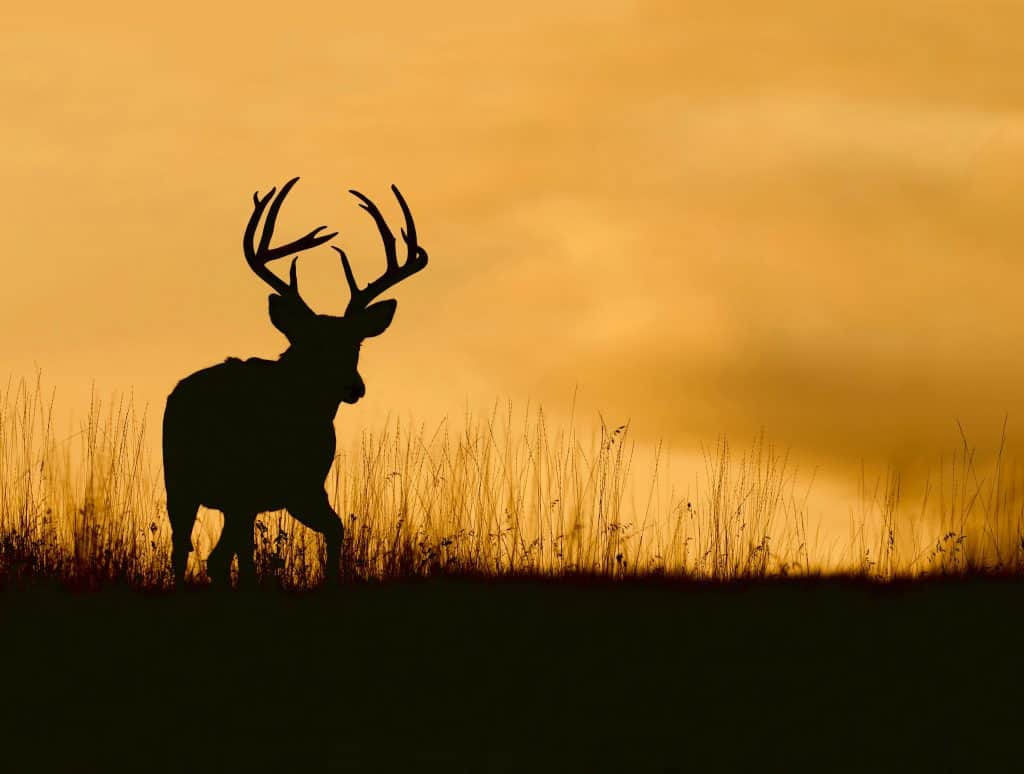
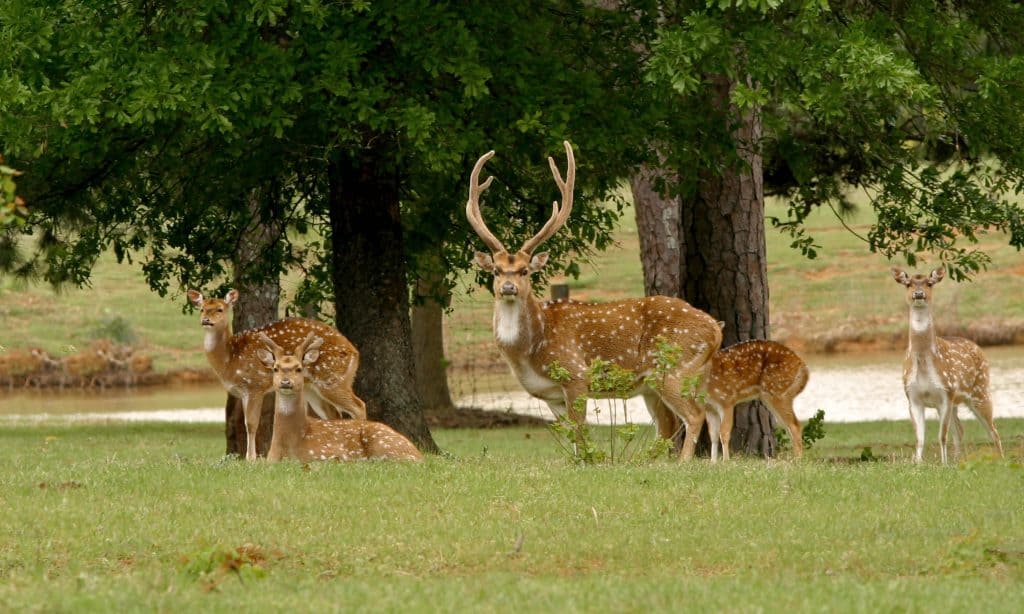 It lives in grasslands and forests in India and Sri Lanka in herds of up to 100 or more. It stands 35–37 inches at the shoulder. Its spotted coat is reddish brown above and white below. The male chital has branching, usually three-tined antlers up to 100 cm long.
It lives in grasslands and forests in India and Sri Lanka in herds of up to 100 or more. It stands 35–37 inches at the shoulder. Its spotted coat is reddish brown above and white below. The male chital has branching, usually three-tined antlers up to 100 cm long. 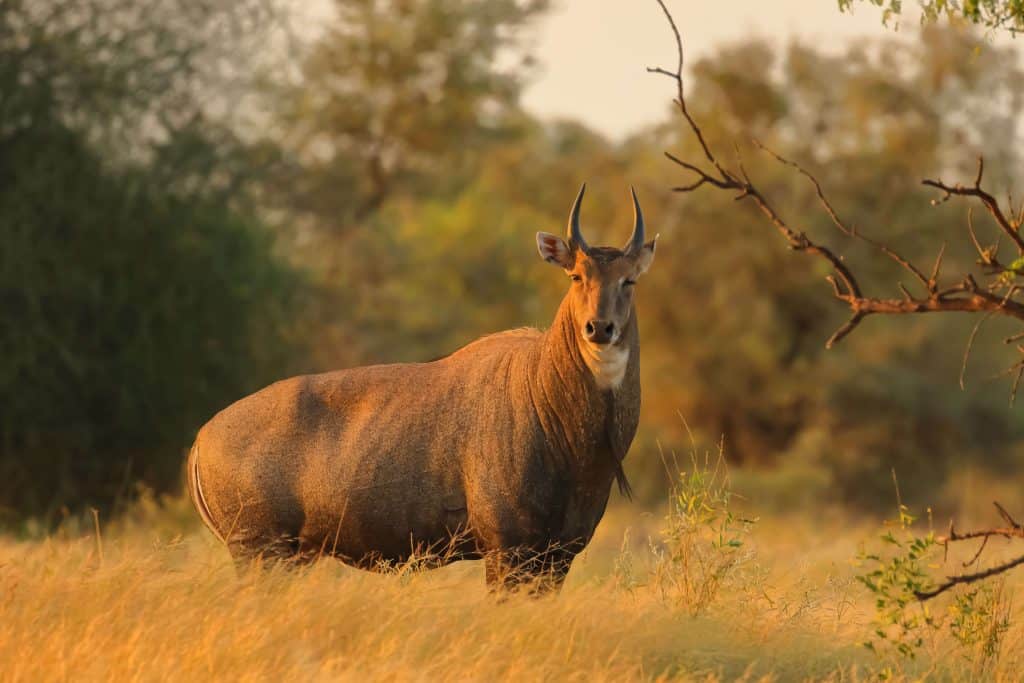 The nilgai is indigenous to the Indian subcontinent, and Hindus accord it the same sacred status as cattle. Accordingly, the nilgai is the only one of the four Indian antelopes that are still abundant. The nilgai’s conformation is more horselike than cowlike: it has a long neck with a short upright mane, a narrow bony head, a barrel-like chest, and strong legs. Maximum contrast is achieved in prime males, which turn nearly black. They grow much bigger than cows, up to 5 feet tall and 660 pounds, compared with 471 pounds for cows; they also have a thicker neck and a tassel of black hair bordering the white bib.
The nilgai is indigenous to the Indian subcontinent, and Hindus accord it the same sacred status as cattle. Accordingly, the nilgai is the only one of the four Indian antelopes that are still abundant. The nilgai’s conformation is more horselike than cowlike: it has a long neck with a short upright mane, a narrow bony head, a barrel-like chest, and strong legs. Maximum contrast is achieved in prime males, which turn nearly black. They grow much bigger than cows, up to 5 feet tall and 660 pounds, compared with 471 pounds for cows; they also have a thicker neck and a tassel of black hair bordering the white bib. 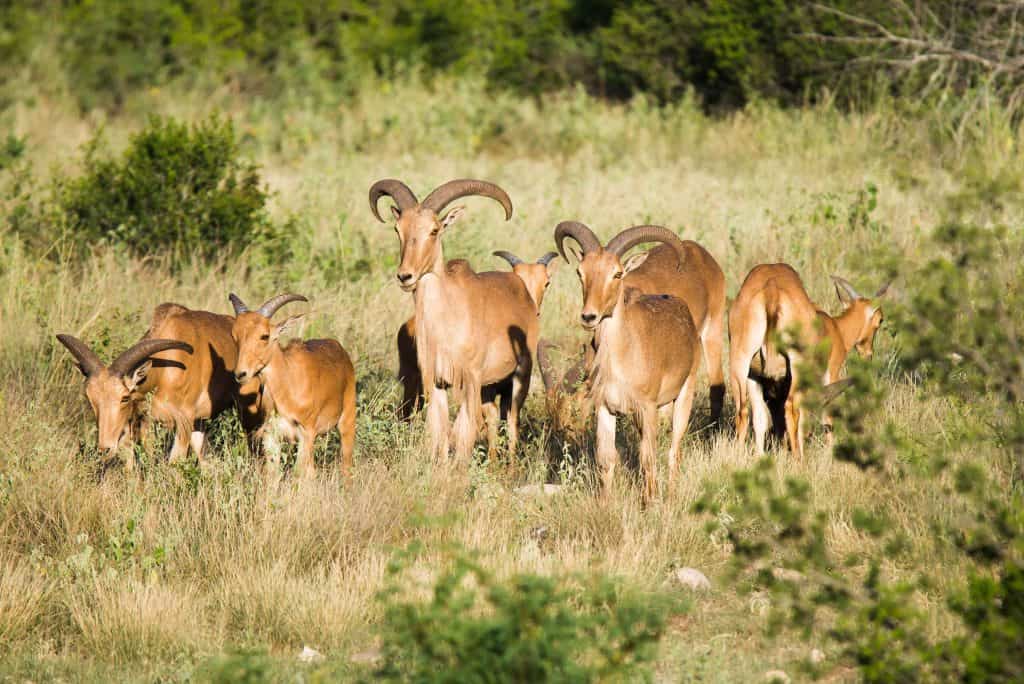
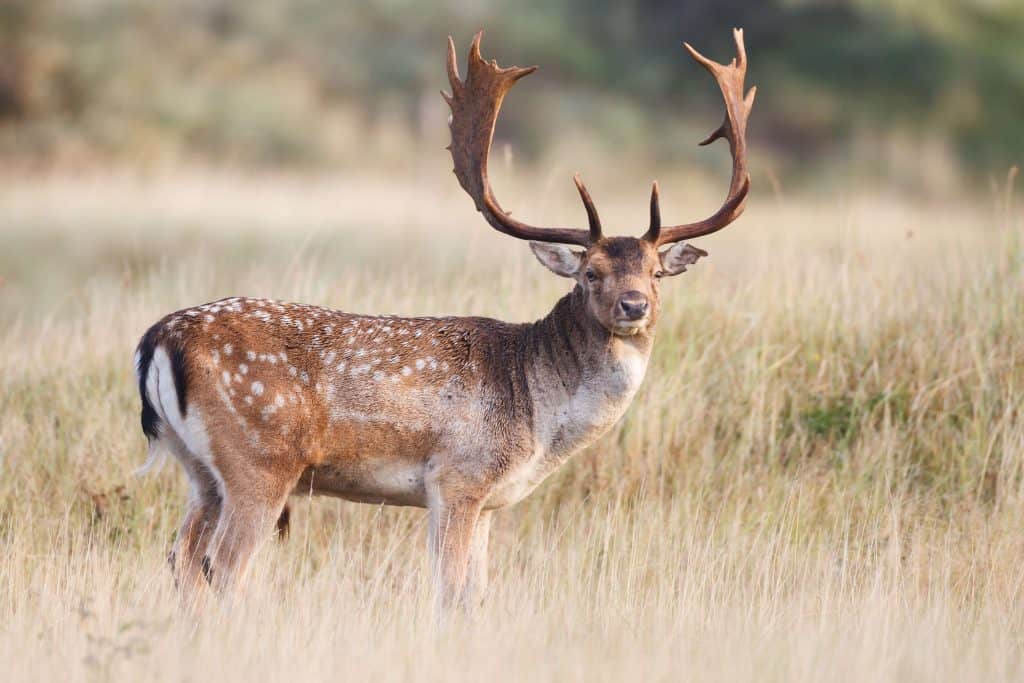
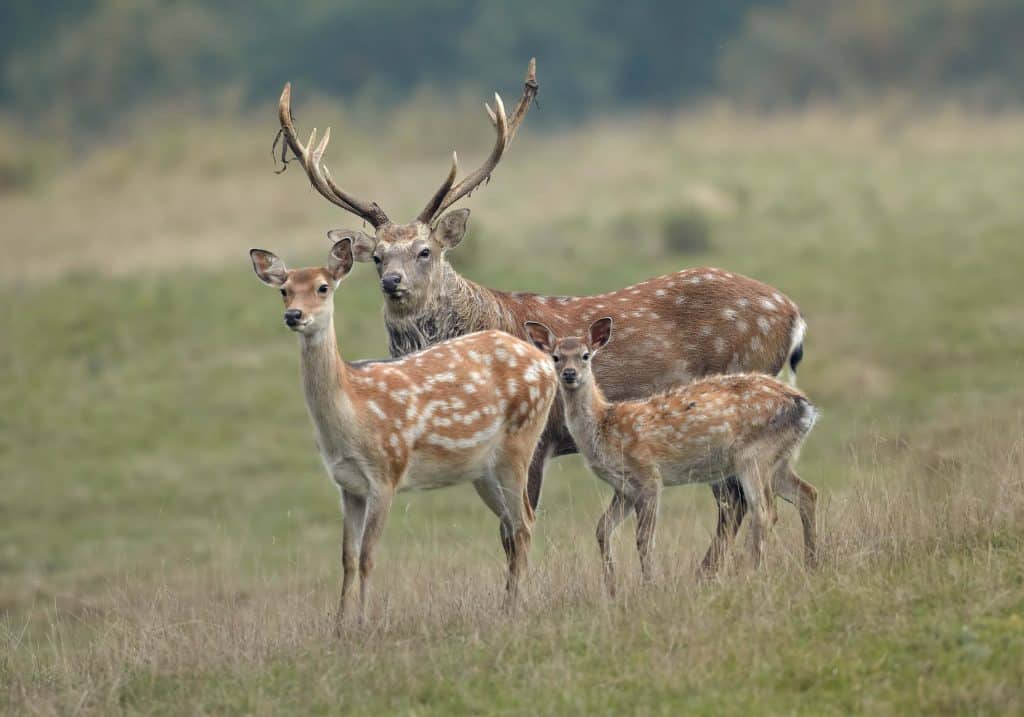 A small, forest-dwelling deer that is native to China, Korea, and Japan, where it was long considered sacred. It is farmed in China for its antlers, which are used in traditional medicine. Mature males of the smallest forms, the southern sikas, stand 31–34 inches at the shoulder and weigh about 180 pounds. Males of the most prominent forms, the northern sikas, such as Dybowski’s sika, stand approximately 40 inches at the shoulder and weigh 240 pounds. Females weigh about 60 percent as much as males. There is considerable geographic variation in size, coat characteristics, and color. Their coats are reddish brown and spotted in summer, dark brown, and sometimes without spots in winter. All have relatively long tails and a white rump patch rimmed by long white hair that can be flared wide in alarm. All mature stags grow a neck ruff in the fall. The four-tined antlers of older stags may exceed 33 inches in length in the north and 28 inches in the south.
A small, forest-dwelling deer that is native to China, Korea, and Japan, where it was long considered sacred. It is farmed in China for its antlers, which are used in traditional medicine. Mature males of the smallest forms, the southern sikas, stand 31–34 inches at the shoulder and weigh about 180 pounds. Males of the most prominent forms, the northern sikas, such as Dybowski’s sika, stand approximately 40 inches at the shoulder and weigh 240 pounds. Females weigh about 60 percent as much as males. There is considerable geographic variation in size, coat characteristics, and color. Their coats are reddish brown and spotted in summer, dark brown, and sometimes without spots in winter. All have relatively long tails and a white rump patch rimmed by long white hair that can be flared wide in alarm. All mature stags grow a neck ruff in the fall. The four-tined antlers of older stags may exceed 33 inches in length in the north and 28 inches in the south.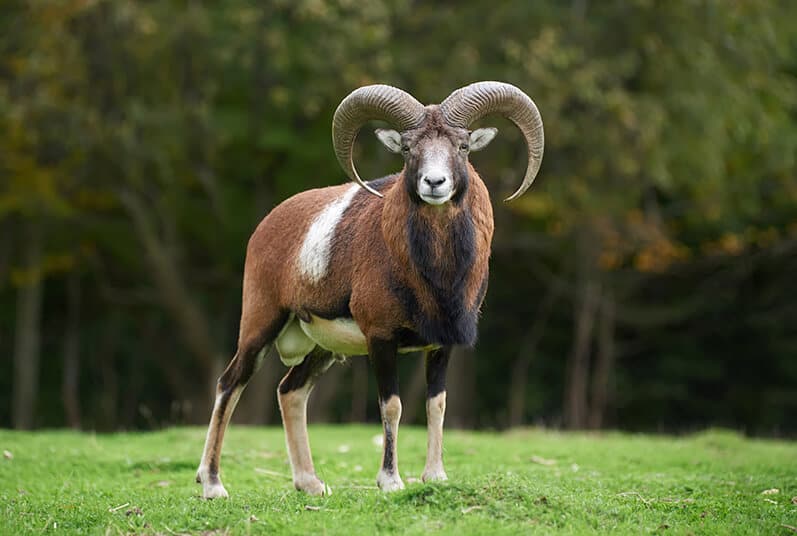 Native to the Mediterranean islands, the mouflon sheep is muscular with a noble build. It is very athletic and sleek in its stance, about 28 inches at the shoulder, and brown with white underparts. The male has a light, saddle-shaped mark on its back and has large, downward-curving horns with the tips turned outward. The female is usually hornless. Like domestic sheep, mouflons mainly eat grass but occasionally browse from shrubs or trees.
Native to the Mediterranean islands, the mouflon sheep is muscular with a noble build. It is very athletic and sleek in its stance, about 28 inches at the shoulder, and brown with white underparts. The male has a light, saddle-shaped mark on its back and has large, downward-curving horns with the tips turned outward. The female is usually hornless. Like domestic sheep, mouflons mainly eat grass but occasionally browse from shrubs or trees.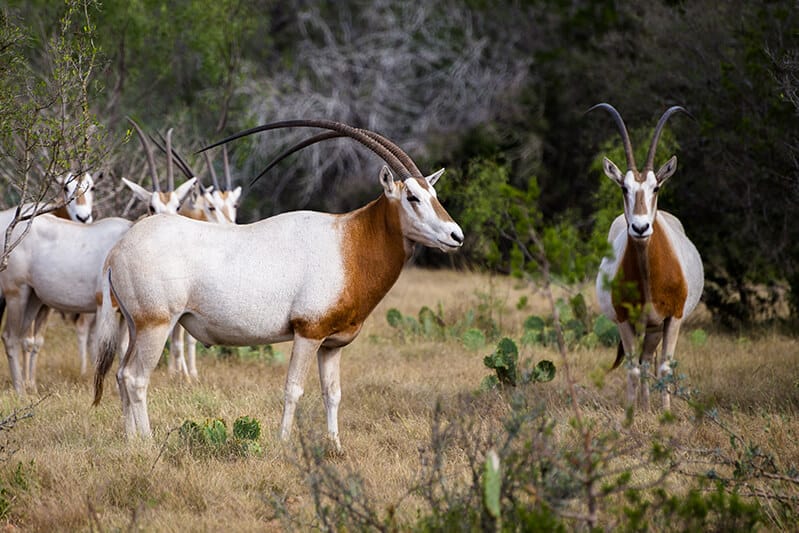 The male and female scimitar oryx sport the famed long, ribbed, backward-curving horns. Primarily white with reddish brown necks and markings, the scimitar oryx has a long, dark, tufted tail. These desert antelope stand up to 4.6 feet tall at the shoulder with a head and body length between 4.9 and 7.5 feet. They weigh approximately 220 pounds (females) and 460 pounds (males). Scimitar oryx live about 27 years in captivity. They are herbivorous, feeding on annual grasses, herbs, juicy roots, buds, and, when water is scarce, on fruits and vegetables. Hundreds of thousands of oryx roamed the Sahara and Sahel regions of Northern Africa only a century ago. Because of human disturbance, overhunting, drought, and excessive livestock grazing, the scimitar oryx is now believed to be extinct in the wild. Surveys show that Niger and Chad may have appropriate habitats for reintroduction, and some reintroductions have begun in Tunisia.
The male and female scimitar oryx sport the famed long, ribbed, backward-curving horns. Primarily white with reddish brown necks and markings, the scimitar oryx has a long, dark, tufted tail. These desert antelope stand up to 4.6 feet tall at the shoulder with a head and body length between 4.9 and 7.5 feet. They weigh approximately 220 pounds (females) and 460 pounds (males). Scimitar oryx live about 27 years in captivity. They are herbivorous, feeding on annual grasses, herbs, juicy roots, buds, and, when water is scarce, on fruits and vegetables. Hundreds of thousands of oryx roamed the Sahara and Sahel regions of Northern Africa only a century ago. Because of human disturbance, overhunting, drought, and excessive livestock grazing, the scimitar oryx is now believed to be extinct in the wild. Surveys show that Niger and Chad may have appropriate habitats for reintroduction, and some reintroductions have begun in Tunisia.